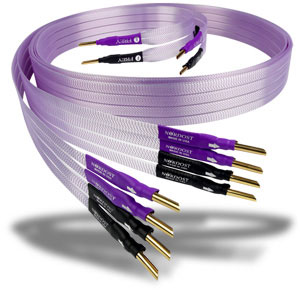Nordost Frey Speaker Cables
by Kirk Midtskog
|
| |||||||||||||
Review Summary
|
Cables fall into a gray area in high-end audio; they're not exactly components, but they can cost as much as a speaker or amplifier. And we certainly can't transfer audio signals without them. Some people use the phrase "snake oil" to describe them. I happen to believe that if users perceive an improvement by using more expensive cables, then that is their prerogative. Likewise, if an equally effective, but less expensive way of connecting audio gear is found, why not go that route? "Cables are over-engineered" is another statement I often hear. It is perhaps less combative and implies that some basic engineering and manufacturing will suffice -- that no extravagant materials or complicated construction are needed. I don’t care one way or the other. If the improvements wrought by exotic materials or techniques are valued by the consumer, so be it. It is not for me to judge the spending choices of others.
Many electrical engineers maintain that a combined set of electrical properties --capacitance, inductance, and impedance -- determine a cable's performance, and that for this reason mere lamp cord will do just as well as expensive, exotic speaker cable. Here I disagree. I have readily heard substantial improvements with "audiophile" cables over the freebies that come with some electronics or the bulk wire you can buy at high-volume electronics stores, which is not to say that increased price always leads to commensurate performance. Materials, construction, and system interactions matter, and some cables do sound better in some situations than others. In fact, I have heard different cables make or break the listenability of some systems.
Having cleared all of that up, I have in hand Frey interconnects ("patch cords" before we got all fancy, $979 USD per meter pair) and Frey speaker cables ($2719 per eight-foot shotgun pair) from Nordost, a company whose products may actually be a standard against which other high-end cables are assessed -- deservedly or not. Nordost did not start the cable craze, but it did hit the market in the early '90s with nearly universal critical praise at all levels of its offerings and has continued to do so year after year. Expensive cables are often assessed against Nordost’s Valhalla (now superseded by Odin), for example.
Nordost has put in some extensive engineering R&D and manufacturing capability over the years. It manufactures all of its cables -- including extruding its own wire -- in a plant in Ashland, Massachusetts, hence the Nordost name, which means "northeast" in the Nordic languages. Frey falls at the top the Norse line, with the Flatline and Reference lines coming in below and above. All make use of flat conductors -- six 26-gauge oxygen-free-copper (OFC) conductors with an extruded silver surface for the interconnects, and 28 24-gauge OFC conductors with the same silver surface for the speaker cables. The interconnect's conductors are wrapped in a FEP Teflon thread wound in a helix. An FEP tube goes over this. They are terminated with WBT NextGen gold-plated-copper connectors. With a dielectric constant of 1.12, Frey speaker cables are said to "transfer signals more efficiently and at extremely high speeds." They are available terminated with spades or Nordost Z plugs, the latter of which look like extensions of the cables themselves.
Getting started
I listened to the Frey interconnects and speaker cables in my reference system and in a friend’s system with which I am quite familiar -- a fabulous sounding all-Gamut collection, including the fairly large L-7 speakers. I did some close listening to the interconnects and the speaker cables separately and mixed with my reference Shunyata Research cables, but mostly I used the Nordost cables together as a combo. The review samples were apparently fully burned in on Nordost’s Vidar break-in device. I also ran the set continuously for two weeks, during which time I did hear some change in sonic character.
